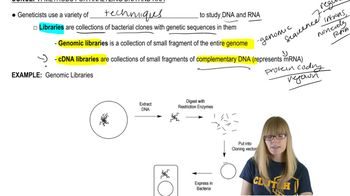Table of contents
- 1. Introduction to Genetics51m
- 2. Mendel's Laws of Inheritance3h 37m
- 3. Extensions to Mendelian Inheritance2h 41m
- 4. Genetic Mapping and Linkage2h 28m
- 5. Genetics of Bacteria and Viruses1h 21m
- 6. Chromosomal Variation1h 48m
- 7. DNA and Chromosome Structure56m
- 8. DNA Replication1h 10m
- 9. Mitosis and Meiosis1h 34m
- 10. Transcription1h 0m
- 11. Translation58m
- 12. Gene Regulation in Prokaryotes1h 19m
- 13. Gene Regulation in Eukaryotes44m
- 14. Genetic Control of Development44m
- 15. Genomes and Genomics1h 50m
- 16. Transposable Elements47m
- 17. Mutation, Repair, and Recombination1h 6m
- 18. Molecular Genetic Tools19m
- 19. Cancer Genetics29m
- 20. Quantitative Genetics1h 26m
- 21. Population Genetics50m
- 22. Evolutionary Genetics29m
18. Molecular Genetic Tools
Methods for Analyzing DNA
Problem 19
Textbook Question
Should the FDA regulate direct-to-consumer genetic tests, or should these tests be available as a 'buyer beware' product?
 Verified step by step guidance
Verified step by step guidance1
span>1. Understand the context: Direct-to-consumer (DTC) genetic tests are those that can be purchased by consumers without the need for a healthcare provider. These tests can provide information about ancestry, health risks, and other genetic traits.</span
span>2. Consider the role of the FDA: The Food and Drug Administration (FDA) is responsible for protecting public health by ensuring the safety, efficacy, and security of drugs, biological products, and medical devices. This includes regulating genetic tests to ensure they are accurate and reliable.</span
span>3. Evaluate the benefits of regulation: Regulation by the FDA could ensure that DTC genetic tests provide accurate and clinically valid results, reducing the risk of consumers making health decisions based on incorrect information.</span
span>4. Consider the 'buyer beware' approach: Without regulation, consumers would need to rely on their own judgment and research to assess the validity and reliability of genetic tests, which could lead to misinformation and potential harm.</span
span>5. Weigh the ethical and practical implications: Consider the balance between consumer autonomy and protection, the potential for misuse of genetic information, and the impact on public health.</span
 Verified video answer for a similar problem:
Verified video answer for a similar problem:This video solution was recommended by our tutors as helpful for the problem above
Video duration:
3mPlay a video:
Was this helpful?
Key Concepts
Here are the essential concepts you must grasp in order to answer the question correctly.
Direct-to-Consumer Genetic Testing
Direct-to-consumer (DTC) genetic testing allows individuals to access their genetic information without the need for a healthcare provider. These tests can provide insights into ancestry, health risks, and traits, but they often lack comprehensive medical guidance. Understanding the implications of DTC testing is crucial, as results can lead to anxiety or misinterpretation without professional context.
Recommended video:
Guided course

Modern Genetics
Regulatory Framework
The regulatory framework for genetic testing involves guidelines and policies that govern the safety, efficacy, and marketing of these tests. In the U.S., the FDA plays a key role in determining whether genetic tests require premarket approval. The debate centers on balancing consumer protection with innovation, as overly stringent regulations may stifle advancements in genetic technology.
Recommended video:
Guided course

Bacteria and Viral Chromosome Structure
Informed Consent and Ethical Considerations
Informed consent is a fundamental ethical principle in healthcare, requiring that individuals understand the risks and benefits before undergoing testing. In the context of DTC genetic tests, consumers must be aware of potential privacy issues, the accuracy of results, and the implications of their genetic information. Ethical considerations also include the potential for discrimination based on genetic data and the need for clear communication from test providers.
Recommended video:
Guided course

Mapping with Markers

 7:40m
7:40mWatch next
Master Methods for Analyzing DNA and RNA with a bite sized video explanation from Kylia Goodner
Start learningRelated Videos
Related Practice


